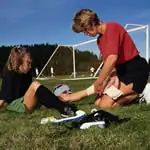
We're all familiar with the old sayings tied to training--athletic and otherwise: Practice makes perfect. No pain, no gain. Suck it up.
But when it comes to kids and teens and their growing bodies, too much training and not enough rest can cause serious problems.
"As adults, we can work ourselves to a higher level of performance--add miles or add pounds lifted," says Dr. Elizabeth Szalay, a pediatric orthopedic surgeon at Carrie Tingley Hospital and an associate professor of pediatric orthopedics and pediatrics at the University of New Mexico.
"But in children there is a finite point, which can't be exceeded without damaging the growth plate, and there's no way to get around that."
Whether powerful pitchers or flexible gymnasts, kids have immature bones and growth plates made up of cartilage cells at the ends of the long bones of their bodies. Those cells are softer and more vulnerable to injury than those in mature bones. When growth is complete, the areas close and are replaced by solid bone.
Children and teens are vulnerable to growth plate injuries as long as there are open growth plates in the body, Szalay says. In most girls, growth plates close from age 14 to 16; in most boys, they close from age 16 to 18. Damage to a growth plate area can have long-term implications, such as the limb being crooked or shorter than the other.
It's important for parents to understand that the pediatric muscular skeletal system can't train in the same way an adult would train, to get to the next level of performance. Kids' growing bones simply can't endure the stress that adult bones can, even when their cardiovascular and muscular strength may be pushing them forward.
"Often times, kids who are participating in athletics are going to have the cardiovascular energy to push themselves," Szalay says. "There's nothing stopping them in energy and output. For them, all they can think about is, 'I want to get to the next level.' ''
That's when it becomes important for parents to keep their perspective.
The American Academy of Pediatrics found that up to 50 percent of all injuries seen in pediatric sports medicine are related to overuse. In a report issued in June, the academy defined an overuse injury as a "micro traumatic injury to a bone, muscle or tendon that has been subjected to repetitive stress without sufficient time to heal or undergo the natural healing process."
To avoid such injury the academy's Council on Sports Medicine and Fitness recommends young athletes limit training in a single sport.
Trainers working with kids this summer at Midtown Sports and Wellness agree.
"Specialization in one sport too early is a problem," says Russell McCarthy, an expert level personal trainer and a coordinator of the Xplosive Training for Kids program at Midtown.
"Concentration in one sport, using the same bones and ligaments in the same way all the time, leads to residual fatigue, and that's why kids are getting injuries. That's why I recommend cross-training for all my kids. We use the pool, the gym and the outdoors."
Becky Freeman, a masterlevel trainer and another Xplosive Training coordinator, says the youth program consists of power, agility and speed training for ages 8 to 18.
"It prepares them to be better at their sports and to show up at practices a better athlete," Freeman says. "But the bottom line is to make it fun for these kids so fitness becomes something they can enjoy the rest of their lives."
Freeman says flexibility and form are the first orders of business for the kids. Body weight exercises, springing and reacting drills, and weights follow. Freeman says personal training for kids is different than for adults and parents should make sure they find a trainer who has the training and knowledge to train kids and teens.
Szalay adds that in terms of weight lifting for prepubescent kids, emphasis should be placed on reps and lower weights. Power lifting can be very dangerous as the strength of the muscle can increase past the strength of the immature bone and the muscle can pull the bone away from the growth cartilage.
Szalay says she starts seeing overuse injuries due to sports specialization at age 8 and beyond.
"When kids get to the point where they want to push through the pain, that's where you get in trouble," she says. "That kicks in around age 8 to 10 when they start listening to friends telling them to suck it up.
"Kids need to know that muscle pain is OK, but joint or bone pain is a definite sign that something is wrong and they should not ignore it."
Parents also need to watch for symptoms of burnout, which include chronic muscle or joint pain, personality changes, decreased sport performance, fatigue, lack of enthusiasm about practice or competition, or difficulty completing ordinary activities, according to the American Academy of Pediatrics.
"A lot of times I see parents who say, 'She loves softball, softball is her life,' '' Szalay says. "While the kid is saying, 'My ankle is killing me,' when it's not even swollen or problematic."
The American Academy of Pediatrics reports that young athletes who participate in a variety of sports have fewer injuries and play sports longer than those who specialize before puberty. Those athletes also have the highest potential to achieve the goal of lifelong fitness and enjoyment of physical activity.
"The most important thing is moderation in everything," Szalay says. "Kids need to be kids. They need to be athletically active but not become excessive about any one sport or activity. They need variety in their lives."
 See more soccer tips for kids or find a youth soccer leagues near you.
See more soccer tips for kids or find a youth soccer leagues near you.
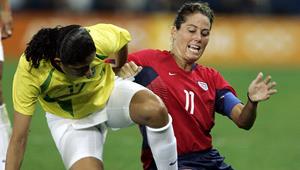

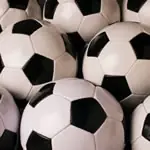

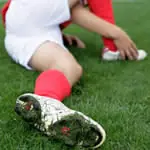
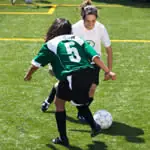
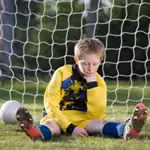
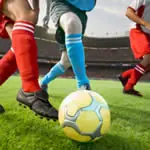
Discuss This Article